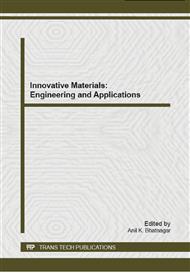p.215
p.220
p.226
p.231
p.242
p.249
p.254
p.258
p.262
Research on Performance of Polyimide In Situ Modification Anionic Polymerization Nylon 6
Abstract:
Through the polymerization and grafting reaction of bisphenol A dianhydride and bisphenol A diamine, the polyimide activator (PI activator) of acyl caprolactam end capping is obtained and then the anionic in-situ polymerization modified nylon 6 resin is obtained. Viscosity analysis shows that PI consumption is higher than 0.1 (of monomer mass), the reaction temperature is higher than 160°C, the viscosity rises rapidly in a short time and the rapid polymerization molding can be realized; when PI consumption is higher than 0.15 (of monomer mass), the water absorption of matrix resin will be lower than 1.4%; compared with the nylon resin, its water absorption is significantly lowered and its mechanical property is improved greatly; microscopic analysis shows that PI molecules fail to enter the crystalline phase of the nylon 6 and form lamellar crystals in the nylon matrix, which plays a role of enhancement and obstruction; differential thermal analysis shows that PI reduces the melting enthalpy and melting point temperature of nylon 6 resin, which indicates that PI reduces the crystallization capacity of nylon 6.
Info:
Periodical:
Pages:
242-248
Citation:
Online since:
October 2014
Authors:
Keywords:
Price:
Сopyright:
© 2014 Trans Tech Publications Ltd. All Rights Reserved
Share:
Citation:


